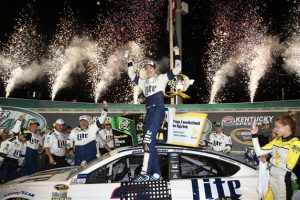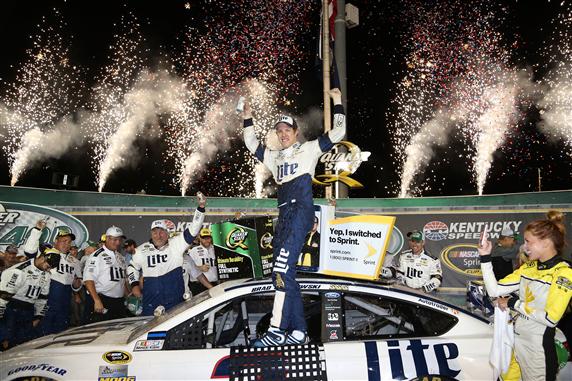
I’ve said for a long while that I am not a big fan of fuel mileage races, although I do at the same time acknowledge they are a necessary evil in the sport.
I say a necessary evil because the thing about these races is that despite a lot of driver input, it ultimately comes down to match, and how much a driver can listen to the voice in his helmet.
There is so much that goes into a race that is determined by not who is the fastest, but who is the best at strategy. It’s knowing how much fuel the gas man got into the car, and how much is remaining in the tank. It’s about the crew chief’s ability to take the lap times, and then calculate how much his driver needs to slow down in order to make it.
Then there’s the driver himself, or herself, because they have to listen to the direction of the crew chief in what to do to make it to that finish. Sometimes it’s letting off the gas at an earlier point, and coasting into the corner rather than getting on the brakes.
Other ways a driver would save fuel, at least when under caution, is keep off the banking, so that the fuel stayed near the pick-up area in the cell so it can make it to the engine. Then there’s one way that often is the most challenging, especially on the fuel-injected engines, and that is actually shutting off the engine. When NASCAR ran the carburetors, it was easy to do because then it was a matter of just hitting a switch at a certain point, then turning it back on.
Not so much now, because the system in the car is computerized, and simply shutting off the engine could mean that the car could not restart immediately.
How do drivers get away with this now?
Many will “clutch” the engine, which in simple terms means the driver pushes in the clutch and can cut off the engine, in essence causing the computer to remember the correct RPM’s when the engine is running. When the clutch is released, engine restarts and away the car goes for another round.
It is a necessary evil, and often not the best racing, but when ya can make it work, it is satisfying.
That’s how Brad Keselowski won on Saturday night, literally winning it on empty. Carl Edwards, in second, was closing in thinking Keselowski ran out, but he kept going, somehow keeping enough fuel in the cell for one final circuit around. Edwards had to drop back slightly, and Keselowski somehow managed to get it across the line. He did, however, not make it to victory lane.
He literally ran out of gas…on the final lap, in the final corner. He coasted the entire way around the track, got the checkered flag, and got pushed to celebrate the victory.
Fuel mileage, whether going 200 MPH around a track, or just trying to improve what the factory has in the daily driver, it’s a necessary evil.
RESULTS: 1-Keselowski 2-Edwards 3-Newman 4-Kurt Busch 5-Stewart 6-Biffle 7-McMurray 8-Kenseth 9-Harvick 10-Truex Jr.
NOTABLE FINISHES: 12-Kyle Busch 13-Earnhardt Jr. 15-Hamlin 32-Johnson 39-Logano
CAUTIONS: 11 for 53 laps.
LEAD CHANGES: 16 among 9 drivers.
TIME OF RACE: 3 Hrs, 6 Mins, 55 Secs.
AVERAGE SPEED: 128.580 MPH
MARGIN OF VICTORY: 0.175 Seconds
CHASE GRID: 1. Keselowski-595 (points), 4 (Wins); 2. Kyle Busch-521, 3; 3. Edwards-566, 2; 4. Johnson-484, 2; 5. Harvick-599, 1; 6. Kurt Busch-583, 1; 7. Logano-533, 1; 8. Truex Jr-514, 1; 9. Kenseth-477, 1; 10. Hamlin-472, 1; 11. Stewart-248, 1; 12. Elliott, -107 (From 1st-Harvick); 13. Newman, -136; 14. Earnhardt Jr, -138; 15. Dillon, -139; 16. McMurray, -160.



